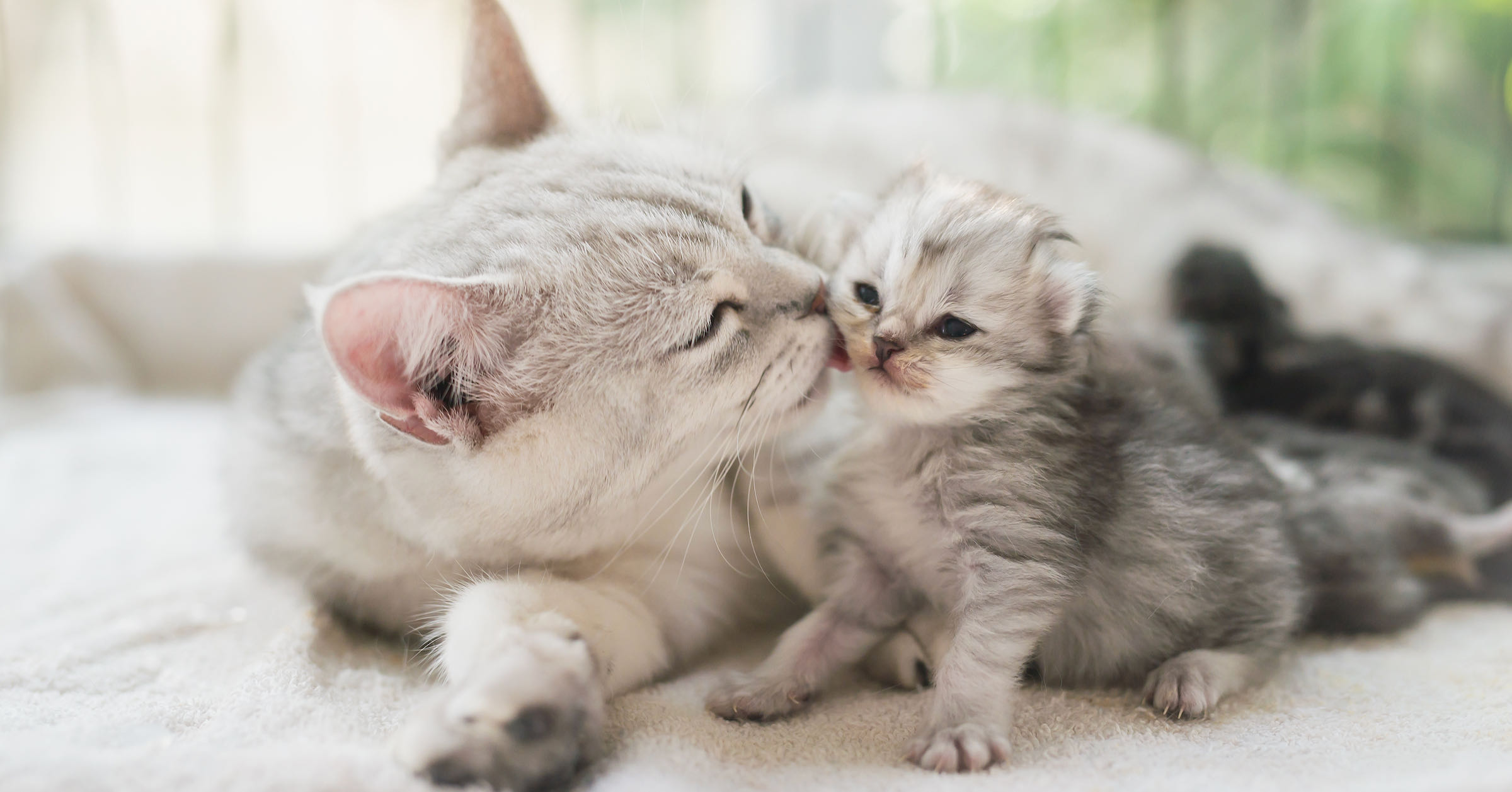Key Points:
- Most cats stop growing around 12-16 months, but some breeds keep growing for up to 4 years.
- Cats grow at different rates depending on breed, gender, genetics, and diet.
- Proper care and nutrition during kittenhood can influence their growth and final size.
That tiny ball of fluff you just brought home? It’s hard to imagine them as anything but a kitten. But as all cat parents know, those precious days fly by.
As your kitten grows toward full-blown cathood, you may wonder when they will reach their final form. In other words, when do cats stop growing? The answer depends on a few factors, and genetics play a big role in how long it takes your cat to fully mature.
Most cats reach their full size around 12-16 months of age, like our teenage growth spurt, minus the awkwardness, the acne, and the regrettable emo phase. However, a few larger breeds may take up to 4 years to fully mature and reach their adult size.
Common cat breeds and when they stop growing
Most cats reach their adult size relatively quickly, with some breeds maturing 1-2 years faster than others. But even within breeds, size can vary depending on genetics, gender, and nutrition.
Tabby cats, Siamese cats, and domestic Shorthair cats will typically stop growing at 12–19 months. Their average adult size is 12-20 inches long, 11 inches tall, and 6-14 pounds.
Savannah cats can grow till they’re 2 years old, reaching 13-20 inches long, 10-19 inches tall, and 12-25 pounds.
Bengal cats, aka tiny leopards, will typically stop growing at 2 years old, weighing in at a solid 10-22 pounds. Their average adult size is 13-16 inches long and 11-13 inches tall.
Ragdoll cats are gentle giants that keep growing until they’re 4 years old. Their average adult size is 15-26 inches long, 9-11 inches tall, and 8-20 pounds.
Maine Coon cats, another large cat breed, will also keep growing for up to 4 years. Their average adult size is 48 inches long, 8-16 inches tall, and 25 pounds.
Factors that determine the size of your kitty
The truth is, a cat’s adult size isn’t always easy to predict. How big your kitten will turn out depends on a variety of factors:
Gender
Male cats grow slower and larger than their female counterparts, even within the same breed. In fact, a male can grow up to 2 pounds larger than his female littermate.
Testosterone causes male cats to develop increased muscle mass and bone density, making them bigger. But this isn’t always set in stone. Just like in humans, some female cats will grow bigger than their male siblings.
Spaying or neutering
While spaying or neutering your cat can affect their growth and size, most cats reach a similar adult size whether they’re fixed or not. However, the timing of the procedure can influence growth.
Cats reach sexual maturity typically between 4-6 months old when their bodies start producing sex hormones like estrogen and testosterone.
Tip: Routine cat health check-ups are important for all cats, but especially kittens. Pumpkin offers a best-in-class pet insurance plan for kittens and cats.
These hormones influence growth and development, including the closure of growth plates. Once these plates close, the cat stops growing taller. Cats fixed early might grow a bit taller due to their growth plates staying open longer, but they won’t necessarily get heavier.
Most veterinarians will recommend spaying or neutering cats at 5 months of age, but shelters and rescues typically fix kittens earlier to decrease the possibility of accidental litters.
Litter size
The number of kittens in a litter also matters. Large litters can put significant strain on the mother cat, limiting the amount of milk supply to each kitten. The average litter size falls between three to six kittens; larger litters occasionally reach nine or more. In fact, a Burmese/Siamese cat who gave birth to 19 kittens holds the Guinness World Record.
With more siblings, there’s more competition over nourishment, warmth, and attention. This can lead to some kittens not getting the nutrition they need. Kittens with poor nutrition grow slower and can end up smaller.
Sometimes, there may be a runt in the litter. Contrary to popular belief, a runt doesn’t mean the last-born, but rather the smallest and weakest in the litter. Providing extra attention and nutrition can help runts catch up, but they may still be slightly smaller than their siblings.

Diet and nutrition
Proper nutrition means proper growth. Your kitten needs a balanced, nutritional diet of kitten food for the first year of its life. Some can require kitten food longer (like the larger cats who are still growing), but most cats can transition to adult cat food at 12 months old.
Kittens will grow rapidly during their first year and will need a diet rich in protein and fat. If you’re not sure how much to feed your kitten, your vet can advise you on the proper amount and the best cat food for your new kitty.
Genetics
Different cat breeds have distinct growth patterns and mature at different rates. For example, mixed-breed cats tend to grow fast and have overall better health compared to purebreds.
Some genetic disorders can affect a cat’s growth, such as pituitary dwarfism or osteochondrodysplasia. Your vet should be able to detect any abnormalities during routine check-ups.
What to expect during each feline life stage
Curious about what the future holds for your kitty? Let’s explore what to expect at each life stage so you can appreciate their antics every step of the way.

Newborn to 6 months
This is the most rapid growth stage. Your kitten will go from a newborn (eyes closed, relying on mom for everything) to a feisty, curious kitten. A healthy kitten should gain roughly 0.03 pounds per day and 0.25 pounds per week.
Sudden drops in weight or a halt in growth could signal health issues, such as infections, parasites, or underlying congenital conditions. Early detection and treatment are important at this stage.
While your cat is still a kitten, consider investing in pet insurance to protect your little furball (and your wallet) from unexpected accidents and illnesses that arise as they mature.
6 months to 12 months
This is your cat’s adolescent stage — think rebellious, rambunctious, and constantly-on-the-go teenagers.
During this stage, your veterinarian may recommend spaying or neutering your kitten, or keeping them away from other cats to avoid mating. Getting your cat fixed during this stage will help prevent unwanted behaviors, like spraying or excessive yowling, as well as health issues down the line.
1 to 4 years
Your cat is officially an adult at this stage. They may continue growing slowly and typically stop completely around 18 months. Most smaller breeds have blossomed into glorious adult cats by now, while large breeds may keep growing.
By four years old, even large breed cats should be at their full adult size. From this point on, any additional growth will come in the form of extra weight. Proper nutrition and plenty of exercise and playtime will help prevent those extra pounds from creeping on and keep your cat healthy.
Tip: You may have looked at your kitten’s paws and wondered if your sweet little kitten will become a monster cat, but kittens differ from puppies. For cats, the paws aren’t a foreshadowing of adult size – but their toe beans are definitely adorable!
Adulthood and senior years
These are your cat’s golden years, and they will likely begin to slow down in time. They may show some weight gain or loss from age-related issues.
If your cat has reached the geriatric stage of life, or “super senior” status (typically 15+ years old), it’s time to prioritize their comfort and quality of life above all else. While it’s never easy to think about, discuss end-of-life care options with your vet so your kitty can live in comfort and dignity in their final days.
The bottom line
Your cat will grow up, trade in those zoomies for long naps, and maybe even develop a taste for the finer things in life (like that expensive catnip and wet food). Regardless of their size, their health and happiness depend on the care and love you provide throughout their lives
Through it all, remember to embrace their quirks and cherish your bond at every stage — even when they’re knocking over your favorite coffee mug.
FAQs
-
- https://www.usatoday.com/story/life/pets/2024/08/22/when-do-cats-stop-growing/74767315007/
- https://www.catster.com/cat-health-care/when-do-cats-stop-growing/
- https://www.petmd.com/cat/conditions/reproductive/cat-pregnancy-and-kittens-complete-guide
- https://www.ncbi.nlm.nih.gov/pmc/articles/PMC10016642/
- https://www.researchgate.net/publication/230025598_The_consequences_of_differences_in_litter_size_for_the_nursing_cat_and_her_kittens
- https://www.petmd.com/cat/general-health/how-many-kittens-can-cats-have
- https://www.guinnessworldrecords.com/world-records/largest-litter-domestic-cat
- https://home4pet.com/is-the-runt-always-born-last/
- https://www.sciencedirect.com/science/article/abs/pii/S2452310017301300
- https://www.petmd.com/cat/conditions/endocrine/c_ct_hypopituitarism
- https://www.sheltermedicine.com/library/guidebooks/guide-to-raising-unweaned-underage-kittens/caring-for-kittens-from-birth-to-eight-weeks
- https://www.petmd.com/cat/conditions/eyes/c_ct_congenital_eye_defects
- https://thecatdoctor.co.uk/cat-health/feline-life-stages/geriatric-cats/
- https://www.cats.org.uk/cats-blog/should-i-get-a-male-or-female-cat




